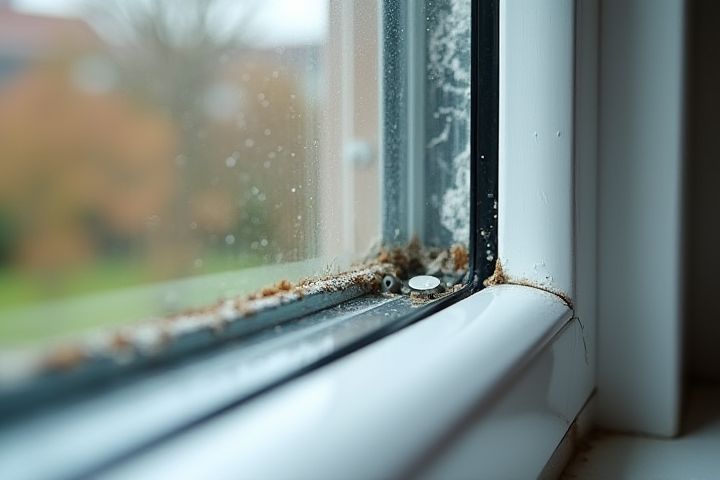
House windows leak primarily due to inadequate sealing, which can occur from deteriorated weatherstripping or poor installation. Age can contribute significantly, as materials like caulk and sealants degrade over time, allowing water to penetrate gaps. Sometimes, windows may be misaligned, preventing proper closure and creating spaces for leaks. Poor drainage systems, such as clogged weep holes, can exacerbate the issue by allowing water to pool around windows. Regular maintenance and inspection are crucial to preventing leaks and prolonging the lifespan of your windows.
Why House Windows Leak
Poor Installation
Poor installation of house windows is a leading cause of leaks, often resulting from improper sealing or insufficient insulation. During installation, failure to align windows correctly can create gaps, allowing water and air to penetrate. In fact, studies show that around 30-40% of window leaks are traced back to installation errors. As a homeowner, ensuring a professional installation can significantly reduce the risk of leaks, safeguarding your property against moisture damage and energy loss.
Damaged Seals
Damaged seals around house windows are a primary cause of leakage, compromising their insulation and allowing moisture to penetrate. Over time, weather fluctuations, UV exposure, and physical wear can deteriorate these seals, leading to gaps. When the window seal fails, water can seep in, creating problems such as mold growth and structural damage. Regular inspection and maintenance of your window seals can help prevent leaks and ensure optimal energy efficiency in your home.
Cracked Glass
Cracked glass in house windows can lead to significant leaks, allowing air and moisture to infiltrate your home. These cracks often result from temperature fluctuations, physical impact, or age-related wear, compromising the window's seal and integrity. When water seeps through, it can cause damage to walls, mold growth, and increased energy costs, as your heating and cooling systems struggle to maintain a consistent temperature. Regular inspections and prompt repairs of cracked glass are essential measures to protect your home and ensure energy efficiency.
Weather Stripping Issues
Weather stripping is crucial for maintaining the integrity of your house windows, as it creates a seal that prevents air and water infiltration. Over time, materials like vinyl or foam can wear down, become brittle, or lose adhesion, leading to gaps that allow rain and moisture to seep through. Inadequate installation or improper sizing of weather stripping may also contribute to leakage, compromising your home's energy efficiency and comfort levels. Regular inspection and timely replacement of weather stripping can enhance your windows' performance, ensuring a dry and energy-efficient living space.
Aging Windows
Aging windows often develop leaks due to the deterioration of seals and weatherstripping that once kept moisture out. Over time, factors such as temperature fluctuations, UV exposure, and general wear can cause the materials to break down, leading to gaps where water can penetrate. You may notice water spots on indoor walls or condensation forming between the glass panes, signaling that it's time to inspect and potentially replace your aging windows. Regular maintenance or investing in new energy-efficient windows can help prevent leaks and enhance your home's overall comfort and energy efficiency.
Condensation Build-up
House windows can leak due to condensation build-up, which occurs when warm, moist air meets the cooler glass surface. This temperature difference causes moisture in the air to condense into water droplets, often pooling at the bottom of the window frame. Over time, continuous condensation can lead to water damage, mold growth, and deterioration of window seals, compromising energy efficiency. To prevent this issue, ensure proper ventilation in your home and consider investing in double or triple-glazed windows that help regulate temperature and reduce condensation.
Clogged Weep Holes
Clogged weep holes are a primary cause of house window leaks, as they prevent proper water drainage from the window frame. These small openings, typically located at the bottom of the window, are designed to allow rainwater to escape, but they can become blocked by debris, dirt, or mold. When weep holes are obstructed, water accumulates, leading to potential damage to window components and adjacent walls. Regular maintenance, including cleaning these weep holes, can significantly reduce the risk of leaks and prolong the lifespan of your windows.
Worn-Out Frames
Worn-out frames are a primary cause of house window leaks, as the material degrades over time due to exposure to weather elements like rain, snow, and UV rays. This deterioration can create gaps between the window frame and the wall, allowing water to infiltrate your home. Signs of wear, such as rotting wood, rusted metal, or cracked vinyl, indicate that the frame is no longer providing adequate protection. To prevent leaks, you should regularly inspect your window frames and consider replacing them when they show significant wear.
High Humidity Levels
High humidity levels can significantly contribute to house windows leaking, as excess moisture in the air creates pressure differences that compromise seals. When the indoor humidity exceeds 60%, condensation can form on window surfaces, leading to water intrusion around frame edges. Regularly maintaining a humidity level between 30% and 50% can help mitigate these leaks, preserving your home's integrity. Inspecting window seals for damage or wear is essential, as a small 1/8-inch gap can lead to substantial water damage over time.
Structural Shifts
House windows can leak due to structural shifts in the building, often caused by settling, thermal expansion, or water damage. As a house settles over time, the frames around the windows may warp or shift, compromising the seal and allowing air and moisture to penetrate. Poorly installed windows can exacerbate this issue, particularly if the frame is not aligned properly with the wall structure. To prevent leaks, ensure your windows are regularly inspected and maintained, addressing any signs of structural instability promptly.
